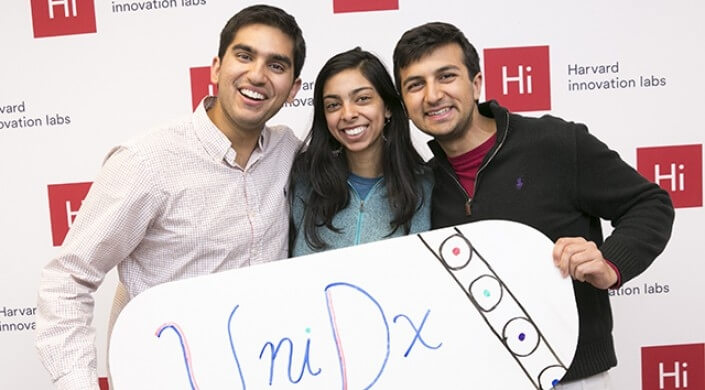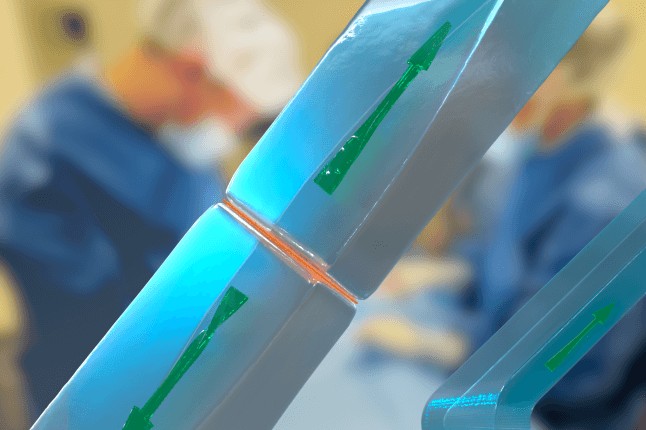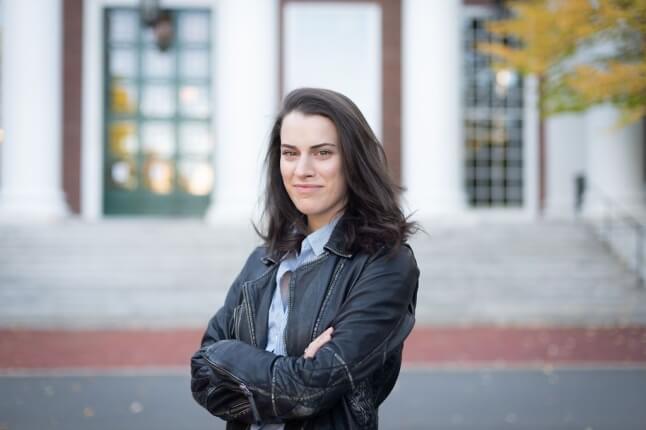News
Applied math concentrators (from left) Rajet Vatsa, Mirai Shah, and Neil Davey launched UniDx to bring the latest microfluidics technology to health workers in developing nations. (Photo courtesy of Neil Davey)
Though malaria was eradicated in the U.S. more than 60 years ago, the disease still claims the lives of half a million people worldwide each year, according to the World Health Organization. With more than 212 million reported cases worldwide and 3.2 billion people living in malaria-endemic countries, the disease remains a pressing global issue.
To improve malaria diagnosis, a team of Harvard John A. Paulson School of Engineering and Applied Sciences (SEAS) students launched a startup to bring the latest microfluidics technology to health workers in developing nations.
UniDx, co-founded by applied math concentrators and recent graduates Neil Davey, Mirai Shah, and Rajet Vatsa, is developing a low-cost device that can detect malaria at an early stage, using only a few drops of a patient’s blood.
“A number of the malaria tests in use today aren’t very sensitive. If you have one rare parasite in a large group of blood cells, those other cells end up masking the parasite you are looking for,” Davey explained. “Microfluidics gives you the power to place one cell or one strand of DNA per drop, and conduct a single DNA amplification reaction per drop, allowing you to have a far more sensitive approach.”
This spring, UniDx won a Public Sector Innovation Award in the Harvard TECH i3 Innovation Challenge, and a $2,500 cash prize, providing important validation of the concept.
Davey has been working on microfluidics in the lab of David Weitz, Mallinckrodt Professor of Physics and Applied Physics, for about five years. The technology is primarily used for DNA or RNA sequencing, or in U.S. hospitals for cancer diagnosis, but hasn’t been widely deployed throughout the developing world.
Microfluidics could be especially useful to detect malaria. Current protein-based tests lack the specificity to distinguish between the four different disease species, leading to less targeted treatments that contribute to antimalarial resistance, Davey said.
Microfluidics gives you the power to place one cell or one strand of DNA per drop, and conduct a single DNA amplification reaction per drop, allowing you to have a far more sensitive approach
The ultrasensitive UniDx technology also improves the accuracy of early detection in patients with very low levels of parasitemia, which could help infected, but asymptomatic individuals, receive treatment before they have the chance to spread the disease.
To make the technology more affordable, the students developed a durable, portable, silicon-based device that only requires a pipette to insert a patient’s blood, rather than the high-priced pumps typically used to create drops. Reagent costs are also very low, since such a small amount of blood is needed.
After winning the Deutsche Bank Challenge and $20,000 in seed funding in early 2017, the students took their prototype to Peru, where they worked with a community health worker to conduct pilot studies on 30 patients in an Amazonian village.
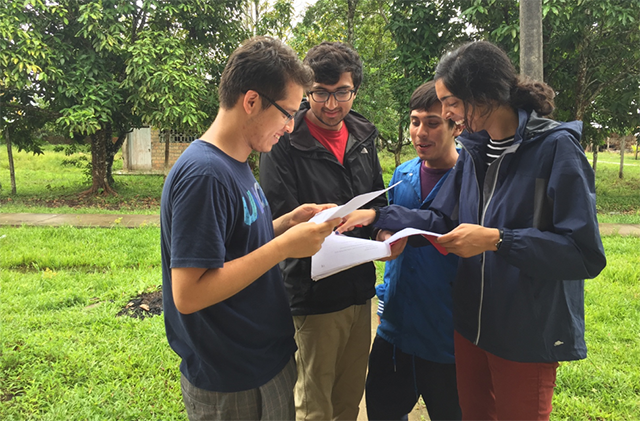
The UniDx team discusses details during the pilot study in the Manacamiri Village in the Peruvian Amazon. (Photo courtesy of Neil Davey)
“Seeing the work translate from the lab to reality was an incredible experience,” said Shah. “We often spend too much time in the lab trying to perfect the technology, and we forget that it is context dependent. You can spend hours analyzing every little chemical reaction, but you don’t truly see the impact the device has, or its flaws, until you understand the environment it will be used in and those who will be most affected by it.”
Six months later, they traveled to the Indian Institute of Technology Bombay, where they completed a technology transfer with a lab that will continue optimizing the device. The UniDx device is being combined with the lab’s low-cost, mobile-phone platform to streamline diagnosis and detection.
In August, the students are planning to launch a 100-patient clinical trial in a Mumbai hospital. As they fine-tune the technology, they are also seeking a partner manufacturer to produce the device at scale.
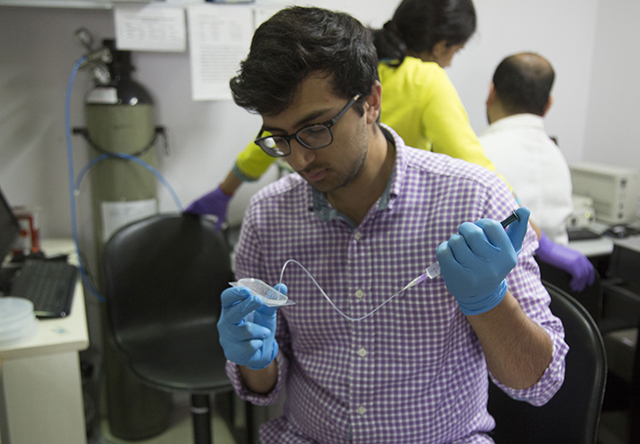
Neil Davey examines the team’s microfluidic device at the Indian Institute of Technology lab in Bombay. (Photo courtesy of Neil Davey)
Implementation is the biggest challenge UniDx now faces, Vatsa said. For the device to be used at scale in high-burden countries, it must be integrated into a nation’s official malaria policy. That often requires WHO endorsement, which can take several years.
National policies also vary widely. Even countries in sub-Saharan Africa that are geographically adjacent may have very different regulatory environments, Vatsa said.
To streamline the process, the team plans to work with global implementation partners like the Program for Appropriate Technology in Health (PATH) and the Foundation for Innovative New Diagnostics (FIND) to enhance awareness about their device and help ministries of health in target nations conduct the operational research and feasibility studies required to implement the technology.
Even though many challenges remain, the students are optimistic about the potential of UniDx to make a global impact
“In social entrepreneurship and innovation, it is important to bring communities from diverse parts of the world together to solve these problems,” Vatsa said. “Just because malaria is a problem in developing communities abroad doesn’t mean that it shouldn’t be a concern in the United States. It is a problem that we all, collectively, have a responsibility to solve.”
Topics: Entrepreneurship, Health / Medicine
Cutting-edge science delivered direct to your inbox.
Join the Harvard SEAS mailing list.
Press Contact
Adam Zewe | 617-496-5878 | azewe@seas.harvard.edu
